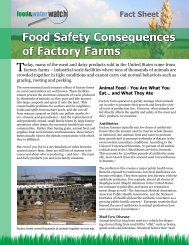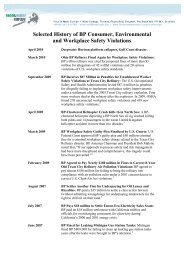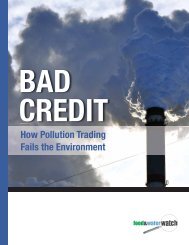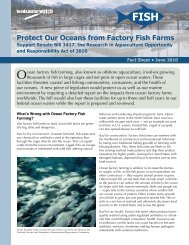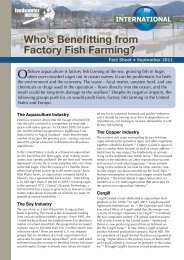How New York State Exaggerated Potential Job Creation from Shale ...
How New York State Exaggerated Potential Job Creation from Shale ...
How New York State Exaggerated Potential Job Creation from Shale ...
Create successful ePaper yourself
Turn your PDF publications into a flip-book with our unique Google optimized e-Paper software.
<strong>How</strong> <strong>New</strong> <strong>York</strong> <strong>State</strong> <strong>Exaggerated</strong> <strong>Potential</strong><br />
<strong>Job</strong> <strong>Creation</strong> <strong>from</strong> <strong>Shale</strong> Gas Development
About Food & Water Watch<br />
Food & Water Watch works to ensure the food, water<br />
and fish we consume is safe, accessible and sustainable.<br />
So we can all enjoy and trust in what we eat and drink,<br />
we help people take charge of where their food comes<br />
<strong>from</strong>, keep clean, affordable, public tap water flowing<br />
freely to our homes, protect the environmental quality<br />
of oceans, force government to do its job protecting<br />
citizens, and educate about the importance of keeping<br />
shared resources under public control.<br />
Food & Water Watch<br />
1616 P St. NW, Suite 300<br />
Washington, DC 20036<br />
tel: (202) 683-2500<br />
fax: (202) 683-2501<br />
info@fwwatch.org<br />
www.foodandwaterwatch.org<br />
<strong>New</strong> <strong>York</strong> Office<br />
155 Water Street<br />
Sixth Floor<br />
Brooklyn, NY 1120<br />
tel: (718) 943-9085<br />
fax: (718) 989-3928<br />
info-ny@fwwatch.org<br />
Copyright © November 2011 by Food & Water Watch.<br />
All rights reserved.<br />
This publication can be viewed or downloaded at<br />
www.foodandwaterwatch.org.
IMAGE © DHALUZA / WIKIMEDIA COMMONS<br />
<strong>How</strong> <strong>New</strong> <strong>York</strong> <strong>State</strong> <strong>Exaggerated</strong> <strong>Potential</strong> <strong>Job</strong><br />
<strong>Creation</strong> <strong>from</strong> <strong>Shale</strong> Gas Development<br />
Executive Summary . ................................................................... 2<br />
Introduction . ......................................................................... 3<br />
<strong>New</strong> <strong>York</strong>’s shale gas job projection . ...................................................... 3<br />
<strong>Shale</strong> gas development would bring few opportunities to current residents . ...................... 7<br />
Additional failures of <strong>New</strong> <strong>York</strong>’s analysis of socioeconomic impacts . ............................ 8<br />
Conclusion . ......................................................................... 10
Executive Summary<br />
High-volume hydraulic fracturing, or fracking, combined with new drilling techniques, has made it costeffective<br />
for the oil and gas industry to extract natural gas <strong>from</strong> underground rock formations called<br />
shales. 1 <strong>How</strong>ever, the costs of the practice to public health, public infrastructure and the environment,<br />
conflicting against the oil and gas industry’s promises of wealth for landowners and jobs for rural communities,<br />
make modern shale gas development controversial.<br />
<strong>New</strong> <strong>York</strong> <strong>State</strong>, much of which sits atop the Marcellus<br />
<strong>Shale</strong> and the Utica <strong>Shale</strong>, is at the center of<br />
this public controversy. The Cuomo administration<br />
is currently considering regulations that would allow<br />
widespread drilling and fracking for shale gas in <strong>New</strong><br />
<strong>York</strong>. The regulations being considered are based on<br />
the state’s 1,537-page environmental impact analysis,<br />
which included a socioeconomic impact analysis with<br />
job and revenue projections for several different shale<br />
gas development scenarios in the state. 2<br />
Food & Water Watch closely examined <strong>New</strong> <strong>York</strong>’s<br />
socioeconomic impact analysis and found that it does<br />
the people of <strong>New</strong> <strong>York</strong> a disservice. The <strong>New</strong> <strong>York</strong><br />
analysis concluded that an “average” shale gas development<br />
scenario would bring 53,969 jobs, but only in<br />
the fine print of a footnote of the widely read factsheet<br />
is it mentioned that this is a 30-year projection. 3<br />
Moreover, Food & Water Watch found that the analysis:<br />
• counts many jobs that would be filled by outof-state<br />
workers, or by workers with shale gas<br />
industry experience who relocate to <strong>New</strong> <strong>York</strong><br />
permanently;<br />
Based on the <strong>New</strong> <strong>York</strong> analysis, Food & Water Watch<br />
estimates that in the first year of the “average” shale<br />
gas development scenario, current <strong>New</strong> <strong>York</strong> residents<br />
can expect only 195 new oil and gas industry job<br />
opportunities. This would grow steadily to over 600<br />
new jobs for current <strong>New</strong> <strong>York</strong> residents in the tenth<br />
year of development, but after this tenth year, there<br />
would be next-to-no new jobs for established <strong>New</strong> <strong>York</strong><br />
residents.<br />
For perspective, the U.S. Bureau of Labor Statistics<br />
estimated that 755,892 <strong>New</strong> <strong>York</strong>ers were unemployed<br />
in August of 2011, 4 and thus the impact of 195 new<br />
oil and gas industry jobs would be about one-fortieth<br />
of 1 percent (i.e., 0.026 percent). This is far <strong>from</strong> the<br />
number of jobs that <strong>New</strong> <strong>York</strong> residents have been led<br />
to expect <strong>from</strong> shale gas development. Such minimal<br />
economic benefits do not justify the near-term and<br />
long-term public costs that would accompany drilling<br />
and fracking for shale gas.<br />
• assumes a rapid pace of shale gas drilling and<br />
fracking under the “average” scenario that would<br />
result in more than 20,000 wells being drilled in<br />
just three counties of the state (Broome, Chemung<br />
and Tioga);<br />
• fails to account for the negative impacts that drilling<br />
and fracking would have on employment in<br />
other industries, such as tourism and agriculture;<br />
• overestimates production jobs by assuming that<br />
shale gas wells will produce for 30 years; and<br />
• misapplies an economic multiplier to estimate the<br />
economic spillover effect of gas industry jobs.<br />
2 Food & Water Watch • www.foodandwaterwatch.org
Introduction<br />
The oil and gas industry, 5 industry-funded academics 6<br />
and ideological think tanks 7 have promoted shale gas<br />
development as a sure-fire job creator in difficult<br />
economic times. Proponents of shale gas development<br />
have benefited <strong>from</strong> media 8 and U.S. government 9<br />
reports in which the supposed economic benefits have<br />
gone unquestioned. Food & Water Watch recently<br />
analyzed one industry-backed job projection and found<br />
that it overstated shale gas job creation potential in<br />
<strong>New</strong> <strong>York</strong> by a factor of 10, or about 900 percent. 10<br />
<strong>New</strong> <strong>York</strong>’s job projection follows a similar methodology<br />
and suffers <strong>from</strong> similar flaws. A topline claim in<br />
the <strong>New</strong> <strong>York</strong> socioeconomic impact analysis is that<br />
53,969 jobs could be created assuming an “average”<br />
scenario of shale gas development. 11 But this is a<br />
30-year projection. 12 It assumes that a total of 42,126<br />
shale gas wells would be developed over 30 years,<br />
including 21,067 in just the three counties of Broome,<br />
Chemung and Tioga. 13<br />
Close examination of this job projection shows that<br />
allowing for such extensive shale gas development<br />
in <strong>New</strong> <strong>York</strong> would actually have a minimal impact<br />
on employment in the near term, primarily because<br />
most jobs would go to employees <strong>from</strong> out-of-state.<br />
<strong>Shale</strong> gas development would not provide the broadbased<br />
economic growth that <strong>New</strong> <strong>York</strong> now needs and<br />
that the industry has promised they could deliver.<br />
Instead, shale gas development would primarily benefit<br />
the oil and gas industry while bringing significant<br />
costs to public health, public infrastructure, and<br />
the environment.<br />
<strong>New</strong> <strong>York</strong>’s shale gas job projection<br />
The consulting company Ecology and Environment, Inc.<br />
(E&E Inc.) was hired to conduct <strong>New</strong> <strong>York</strong>’s analysis of<br />
the impact that shale gas development would have on<br />
employment in the state. 14 E&E Inc. produced a report<br />
describing their methodology and findings that became,<br />
after minor revisions, Section 6.8 of the <strong>New</strong> <strong>York</strong> <strong>State</strong><br />
Department of Conservation (NYSDEC) “Revised Draft<br />
Supplemental Generic Environmental Impact <strong>State</strong>ment”<br />
(SGEIS). 15 Under <strong>New</strong> <strong>York</strong>’s “average” development<br />
scenario, A the analysis concluded that 53,969<br />
jobs would be created <strong>from</strong> drilling and fracking 42,126<br />
shale gas wells over 30 years, compared to the baseline<br />
of no shale gas development. 16<br />
<strong>Job</strong>s before production versus jobs during production<br />
<strong>New</strong> <strong>York</strong>’s 30-year projection of 53,969 jobs comes<br />
<strong>from</strong> three separate projections: a projected 17,634<br />
“construction” jobs <strong>from</strong> the preparing, drilling and<br />
fracking of 1,652 shale gas wells in year 30; a projected<br />
7,161 “production” jobs that have accumulated over<br />
the 30 years as more and more wells are brought into<br />
production; and a projected 29,174 “indirect” jobs created<br />
by the economic spillover effects of construction<br />
and production jobs. 17<br />
A 2009 study by the Marcellus <strong>Shale</strong> Education &<br />
Training Center (MSETC) on future education and<br />
training needs in Pennsylvania is the basis, in the<br />
<strong>New</strong> <strong>York</strong> study, of this distinction between jobs before<br />
production and jobs during production. 18 <strong>How</strong>ever, to<br />
make this distinction, MSETC uses the terms “drilling<br />
phase jobs” and “production phase jobs,” even though<br />
some of the drilling phase jobs are associated with<br />
pre-drilling activities. 19 <strong>New</strong> <strong>York</strong>’s use of the term<br />
“construction jobs” obscures the fact that the drilling<br />
(and pre-drilling) phase of well development includes<br />
white-collar jobs, such as lawyers, lobbyists, accountants,<br />
engineers and office assistants, in addition to<br />
jobs directly associated with building access roads,<br />
constructing pipelines, clearing land and drilling and<br />
fracking. 20 A more accurate distinction is used in this<br />
report: pre-production phase jobs versus production<br />
phase jobs.<br />
It takes less than one year to prepare a well site and<br />
conduct the drilling and fracking. 21 As a consequence,<br />
the number of pre-production phase jobs increases<br />
<strong>from</strong> one year to the next only if the number of new<br />
wells developed each year increases; if the number of<br />
new wells drilled and fracked stays constant, then no<br />
new pre-production phase jobs would be created.<br />
A Three development scenarios were developed based on information<br />
<strong>from</strong> the Independent Oil & Gas Association of <strong>New</strong> <strong>York</strong> (IOGA-NY).<br />
The NYSDEC SGEIS only reports the “low” and “average” development<br />
scenarios.<br />
<strong>How</strong> <strong>New</strong> <strong>York</strong> <strong>State</strong> <strong>Exaggerated</strong> <strong>Potential</strong> <strong>Job</strong> <strong>Creation</strong> <strong>from</strong> <strong>Shale</strong> Gas Development • November 2011 3
Table 1. Annual <strong>Job</strong> <strong>Creation</strong> <strong>from</strong> <strong>Shale</strong> Gas Development Under<br />
<strong>New</strong> <strong>York</strong>’s “Average” Development Scenario<br />
Year<br />
# of new wells drilled<br />
and fracked<br />
# of producing wells<br />
(cumulative)<br />
<strong>New</strong> preproduction<br />
phase jobs<br />
<strong>New</strong> production<br />
phase jobs<br />
1 165 165 1759 28<br />
2 330 496 1771 56<br />
3 496 991 1757 84<br />
4 661 1652 1771 113<br />
5 826 2478 1759 140<br />
6 991 3469 1759 169<br />
7 1156 4626 1771 196<br />
8 1322 5947 1756 225<br />
9 1487 7434 1771 253<br />
10 1652 9086 1760 281<br />
11 1652 10738 0 280<br />
12 1652 12390 0 281<br />
13 1652 14042 0 281<br />
14 1652 15694 0 281<br />
15 1652 17346 0 281<br />
16 1652 18998 0 281<br />
17 1652 20650 0 281<br />
18 1652 22302 0 280<br />
19 1652 23954 0<br />
281<br />
20 1652 25606 0 281<br />
21 1652 27258 0 281<br />
22 1652 28910 0 281<br />
23 1652 30562 0 281<br />
24 1652 32214 0 280<br />
25 1652 33866 0 281<br />
26 1652<br />
35518 0 281<br />
27 1652<br />
37170 0 281<br />
28 1652 38822 0 281<br />
29 1652 40474 0 281<br />
30 1652 42126 0 280<br />
31 0 41961 -17634 -28<br />
Note: The reason for the variability in the number of new pre-production jobs during the first 10 years is unexplained<br />
in the E&E Inc. report.<br />
Source: Ecology and Environment Inc. 2011, Table 4-7 for new jobs projected, pages 4-2 and 4-3 for wells drilled and<br />
fracked per year<br />
4 Food & Water Watch • www.foodandwaterwatch.org
The <strong>New</strong> <strong>York</strong> job projection assumes that for the first<br />
10 years there is constant growth in the number of<br />
new wells developed each year, <strong>from</strong> 165 new wells in<br />
the first year to 1,652 new wells in the tenth year. 22<br />
(See Table 1.) Development is then assumed to level<br />
off for years 11 through 30 at 1,652 new wells a year. 23<br />
This means there would not be any new pre-production<br />
phase jobs after year 10.<br />
Production jobs, in contrast, would accumulate as<br />
more wells are brought into production. The <strong>New</strong><br />
<strong>York</strong> job projection assumes that a shale gas well will<br />
produce for 30 years, so in year 31 the first shale gas<br />
wells would be retired under the development scenario.<br />
<strong>How</strong>ever, while production jobs would accumulate,<br />
the pre-production phase of shale gas development<br />
requires many times more workers per well than the<br />
production phase. 24<br />
The <strong>New</strong> <strong>York</strong> analysis, relying on the 2009 MSETC<br />
study, estimated that the pre-production phase requires<br />
the equivalent B of about 10.7 full-time workers<br />
per well. C25 In contrast, again based on the MSETC<br />
study, the <strong>New</strong> <strong>York</strong> analysis assumed that the production<br />
phase requires the equivalent of 0.17 fulltime<br />
workers per well, or about one full-time worker<br />
to manage the production of six active wells. 26 These<br />
estimates of the full-time equivalent (FTE) workforce<br />
needed per well, combined with the number of new<br />
wells developed and the number of producing wells,<br />
allowed <strong>New</strong> <strong>York</strong> to project the number of preproduction<br />
and production jobs each year under each<br />
development scenario. (See Table 1 for annual job<br />
creation under the “average” development scenario.)<br />
Indirect job impacts<br />
<strong>New</strong> <strong>York</strong> considers pre-production and production<br />
phase jobs as “direct jobs,” <strong>from</strong> which there is an<br />
economic spillover effect that creates “indirect jobs.” 27<br />
The <strong>New</strong> <strong>York</strong> analysis used the Bureau of Economic<br />
Analysis (BEA) Regional Input-Output Modeling<br />
System (RIMS II) Type I employment multiplier to<br />
project indirect job impacts under the different development<br />
scenarios. 28 Specifically, the analysis used the<br />
oil and gas industry RIMS II Type I multiplier of<br />
2.1766, estimated for the state of <strong>New</strong> <strong>York</strong>. 29<br />
This assumption means that for each direct job created<br />
<strong>from</strong> shale gas development, an additional 1.1766<br />
“indirect” jobs would be created (i.e., 2.1766 - 1). Thus,<br />
<strong>New</strong> <strong>York</strong> projected 29,174 “indirect” jobs by multiplying<br />
1.1766 times the sum of the projected 17,634<br />
“construction” jobs and 7,161 “production” jobs. 30<br />
For reasons detailed below, however, <strong>New</strong> <strong>York</strong>’s<br />
projections of direct and indirect job creation <strong>from</strong><br />
shale gas development are deeply flawed.<br />
B The MSETC study measures jobs in terms of full-time equivalent (FTE)<br />
workers working 2,080 hours per year. Hundreds of different workers<br />
may work on a given well at a given time, but in many cases only for a<br />
few days.<br />
C The <strong>New</strong> <strong>York</strong> analysis assumes that 10 percent of shale gas wells<br />
in <strong>New</strong> <strong>York</strong> would be vertical, and 90 percent horizontal. <strong>New</strong> <strong>York</strong><br />
adopted a Marcellus <strong>Shale</strong> Education & Training Center (MSETC)<br />
estimate of 11.53 full-time workers per horizontal well in Pennsylvania,<br />
then assumed that the 10 percent of wells that would be vertical<br />
were about 70 percent less intensive to drill. To arrive at an adjusted<br />
estimate of full-time workers per well, the calculation is 0.90*11.53 +<br />
0.10*(11.53*0.2777) = 10.7.<br />
<strong>How</strong> <strong>New</strong> <strong>York</strong> <strong>State</strong> <strong>Exaggerated</strong> <strong>Potential</strong> <strong>Job</strong> <strong>Creation</strong> <strong>from</strong> <strong>Shale</strong> Gas Development • November 2011 5
Table 2. Minimal <strong>Job</strong> <strong>Creation</strong> for Current Residents of <strong>New</strong> <strong>York</strong><br />
Under the “Average” Development Scenario<br />
Year<br />
# of new wells<br />
drilled<br />
and fracked<br />
<strong>New</strong><br />
pre-production<br />
phase jobs (total)<br />
<strong>New</strong> pre-production<br />
jobs for “transient”<br />
workers<br />
<strong>New</strong> pre-production<br />
jobs for “permanent”<br />
workers<br />
<strong>New</strong> pre-production<br />
jobs to current<br />
NY residents<br />
1 165 1759 1370 389 194.5<br />
2 330 1771 1,305 466 233<br />
3 496 1757 1,212 545 272.5<br />
4 661 1771 1,134 637 318.5<br />
5 826 1759 1,030 729 364.5<br />
6 991 1759 930 829 414.5<br />
7 1156 1771 833 938 469<br />
8 1322 1756 715 1041 520.5<br />
9 1487 1771 614 1157 578.5<br />
10 1652 1760 496 1264 632<br />
11 1652 0 -523 523 0<br />
12 1652 0 -526 526 0<br />
13 1652 0 -524 524 0<br />
14 1652 0 -518 518 0<br />
15 1652 0 -510 510 0<br />
16 1652 0 -497 497 0<br />
17 165 2 0 -483 483 0<br />
18 1652 0 -465 465 0<br />
19 1652 0 -445 445 0<br />
20 1652 0 -423 423 0<br />
21 1652 0 -401 401 0<br />
22 1652 0 -377 377 0<br />
23 1652 0 -353 353 0<br />
24 1652 0 -329 329 0<br />
25 1652 0 -306 306 0<br />
26 1652 0 -282 282 0<br />
27 1652 0 -259 259 0<br />
28 1652 0 -239 239 0<br />
29 1652 0 -217 217 0<br />
30 1652 0 -199 199 0<br />
31 0 -17634<br />
Note: Instead of distinguishing between in-state and out-of-state workers, the <strong>New</strong> <strong>York</strong> analysis chose to describe<br />
pre-production phase workers as either transient or permanent. Although adopted in this table, this is inappropriate<br />
terminology since many out-of-state workers are permanent hires who move <strong>from</strong> site to site, while some in-state<br />
workers, such as in construction, may be temporary and/or transient workers.<br />
Source: Ecology and Environment Inc. 2011, Table 4-27. Estimate of new pre-production phase jobs to current residents<br />
based on the assumption that half of new “permanent” pre-production phase jobs go to workers who have moved<br />
to <strong>New</strong> <strong>York</strong> for shale gas development jobs.<br />
6 Food & Water Watch • www.foodandwaterwatch.org
<strong>Shale</strong> gas development would<br />
bring few opportunities to<br />
current residents<br />
The <strong>New</strong> <strong>York</strong> analysis noted that most pre-production<br />
jobs would go to transient, out-of-state workers in<br />
the early years of shale gas development. 31 A 2011<br />
MSETC study estimated that 70 to 80 percent of<br />
employees were out-of-state during the early stages of<br />
Pennsylvania shale gas development. 32 According to<br />
interviews and surveys conducted by MSETC, however,<br />
the out-of-state portion of newly hired workers<br />
was 25–35 percent. 33 This apparent improvement in<br />
in-state hiring may have been due in part to out-ofstate<br />
workers having established in-state residence,<br />
since in the MSETC study an employee that had lived<br />
in Pennsylvania for at least one year and had a valid<br />
PA driver’s license qualified as an in-state worker. 34<br />
This reveals a subtle but crucial problem with the way<br />
the <strong>New</strong> <strong>York</strong> job projection has been presented. Many<br />
of the pre-production jobs that <strong>New</strong> <strong>York</strong> projected as<br />
“permanent employment” would actually go to workers<br />
who had moved to the state to continue their oil<br />
and gas industry employment, not to current residents<br />
of <strong>New</strong> <strong>York</strong> who have been led to believe that<br />
allowing shale gas development would bring new job<br />
opportunities for them.<br />
Table 2 shows the annual pre-production phase job<br />
creation projected by <strong>New</strong> <strong>York</strong>, broken down between<br />
new jobs for transient and permanent workers. In the<br />
first year, <strong>New</strong> <strong>York</strong> assumed that only 22 percent of<br />
new pre-production phase hires would be permanent,<br />
and that the percentage of permanent new hires<br />
would steadily increase to 72 percent in year 10. 35 The<br />
fifth column of Table 2 lists the number of new production<br />
phase jobs for permanent workers that are<br />
projected by <strong>New</strong> <strong>York</strong> under these assumptions: 389<br />
in the first year, an additional 466 in the second year,<br />
and so on. <strong>How</strong>ever, as discussed above, many of these<br />
permanent workers do not currently reside in <strong>New</strong><br />
<strong>York</strong> — they would have come <strong>from</strong> other states, most<br />
likely states that currently allow shale gas development.<br />
To illustrate this effect, Food & Water Watch assumed<br />
that half of the new permanent jobs directly associated<br />
with the pre-production phase of shale gas development<br />
were taken by employees who had moved to<br />
<strong>New</strong> <strong>York</strong> <strong>State</strong> for such work. Under this assumption,<br />
pre-production phase employment of current <strong>New</strong><br />
<strong>York</strong> residents would only grow in the first 10 years,<br />
with 195 new jobs available in the first year increasing<br />
to 632 new jobs available in the tenth year. After<br />
year 10, based on the <strong>New</strong> <strong>York</strong> analysis, the only new<br />
permanent pre-production phase hires would be <strong>from</strong><br />
the transitioning of the transient workforce.<br />
For perspective, the U.S. Bureau of Labor Statistics<br />
estimated that 755,892 <strong>New</strong> <strong>York</strong>ers were unemployed<br />
in August 2011. 36 Using this figure, the impact of 195<br />
new oil and gas industry jobs would be about one-fortieth<br />
of 1 percent (i.e., 0.026 percent). This is far <strong>from</strong><br />
the number of jobs <strong>New</strong> <strong>York</strong> residents have been led<br />
to expect.<br />
<strong>How</strong> <strong>New</strong> <strong>York</strong> <strong>State</strong> <strong>Exaggerated</strong> <strong>Potential</strong> <strong>Job</strong> <strong>Creation</strong> <strong>from</strong> <strong>Shale</strong> Gas Development • November 2011 7
Additional failures of <strong>New</strong> <strong>York</strong>’s<br />
analysis of socioeconomic impacts<br />
The “average” development scenario would rapidly<br />
expand drilling and fracking<br />
The “average” scenario assumed that 165 new wells<br />
would be drilled and fracked in the first year of development,<br />
increasing gradually to 1,652 new wells<br />
in the tenth year of development (see Table 1), after<br />
which point the annual number of new wells would<br />
stay at 1,652. For comparison, in Pennsylvania in<br />
2010 there were 1,405 new wells developed, and 2,459<br />
new wells have been projected for development in year<br />
2015. 38 <strong>New</strong> <strong>York</strong>’s rapid pace of shale gas development<br />
would be concentrated in certain counties, 39 and<br />
it is far <strong>from</strong> certain that such development could be<br />
sustained for 30 years.<br />
The <strong>New</strong> <strong>York</strong> analysis assumes that 50 percent of<br />
the wells would be located in just three counties:<br />
Broome, Chemung and Tioga. 40 Under the “average”<br />
development scenario, the number of new wells would<br />
increase gradually until reaching 826 new wells per<br />
year in years 10 through 30 in these three counties. 41<br />
In total, 21,067 wells would be developed in these<br />
three counties. 42<br />
With such extensive shale gas development, significant<br />
negative impacts on other parts of the economy,<br />
such as agriculture and tourism, would likely result,<br />
but the <strong>New</strong> <strong>York</strong> analysis fails to account for such<br />
negative impacts.<br />
Negative impacts on employment in agriculture and<br />
tourism <strong>from</strong> shale gas development are dismissed<br />
with a spurious argument<br />
Although the <strong>New</strong> <strong>York</strong> analysis acknowledges that<br />
shale gas development could have negative impacts on<br />
employment in other industries, these potential negative<br />
impacts are not included in the job projections. 43<br />
Instead, the <strong>New</strong> <strong>York</strong> analysis dismisses the significance<br />
of such negative impacts with the simple argument<br />
that “Cattaraugus and Chautauqua Counties<br />
still have healthy tourism sectors despite having more<br />
than 3,900 active natural gas wells in the region.” 44<br />
But the fact that tourism and agriculture exist as industries<br />
in Chautauqua and Cattaraugus counties is<br />
not a serious argument. It is quite possible that tourism<br />
would have been greater in these counties were<br />
it not for the past and current gas drilling. Moreover,<br />
modern shale gas development is far more intensive<br />
than conventional natural gas development: much longer<br />
boreholes drilled, much more fracking fluid used,<br />
much more wastewater created and much more heavyduty<br />
truck traffic. 45<br />
The cumulative impacts that such development would<br />
have on other parts of rural economies may be difficult<br />
to quantify, but they must not be dismissed.<br />
Thirty years of shale gas production per well is optimistic,<br />
meaning production jobs are likely overstated<br />
In projecting production phase jobs, the <strong>New</strong> <strong>York</strong><br />
analysis assumed that each new well produces shale<br />
gas for 30 years, and further assumed that the estimate<br />
of 0.17 FTE production phase workers per well<br />
would hold for all 30 years. 46 But this estimate, taken<br />
<strong>from</strong> the 2009 MSETC report, is based on only a few<br />
years of shale gas production in Pennsylvania. 47 This<br />
introduces significant uncertainty into <strong>New</strong> <strong>York</strong>’s<br />
production phase job projection. <strong>New</strong> <strong>York</strong> assumes<br />
that production of a typical horizontal well will fall by<br />
75 percent <strong>from</strong> year 1 to year 4, and by 90 percent<br />
by year 15. 48 But if production falls more rapidly than<br />
expected, then there would be fewer production phase<br />
jobs over the long term. Indeed, the U.S. Securities<br />
and Exchange Commission is investigating whether<br />
shale gas companies have overstated the productivity<br />
of shale gas wells. 49<br />
Rapidly changing estimates of the amount of recoverable<br />
shale gas also raise questions about future well<br />
productivity, 50 suggesting that the amount of gas that<br />
can be recovered <strong>from</strong> a given location of the shale<br />
may vary significantly <strong>from</strong> well to well.<br />
8 Food & Water Watch • www.foodandwaterwatch.org
Incorrect use of employment multipliers exaggerated<br />
indirect job impacts<br />
Finally, <strong>New</strong> <strong>York</strong> misused employment multipliers in<br />
a way that exaggerated the potential economic spillover<br />
effect <strong>from</strong> pre-production and production phase<br />
jobs. <strong>New</strong> <strong>York</strong> went on to misuse economic multipliers<br />
in a way that exaggerated the potential economic<br />
spillover effect <strong>from</strong> these jobs.<br />
Indirect jobs are those that would be created down<br />
supply chains due to demand created by pre-production<br />
and production phase jobs, i.e., <strong>from</strong> “direct” jobs.<br />
The <strong>New</strong> <strong>York</strong> analysis used the Bureau of Economic<br />
Analysis (BEA) Regional Input-Output Modeling<br />
System (RIMS II) Type I employment multiplier to<br />
project indirect job impacts that would stem <strong>from</strong> preproduction<br />
and production phase jobs. 51 Specifically,<br />
the <strong>New</strong> <strong>York</strong> analysis adopted the oil and gas industry<br />
RIMS II Type I multiplier of 2.1766 for the state<br />
of <strong>New</strong> <strong>York</strong>. 52 Under this assumption, each direct job<br />
created <strong>from</strong> shale gas development would lead to an<br />
additional 1.1766 “indirect” jobs (i.e., 2.1766 - 1).<br />
<strong>How</strong>ever, input-output modeling is well suited only for<br />
analyzing the economic impact of clearly defined projects<br />
for which the interdependencies between relevant<br />
economic sectors, over the course of the project, are<br />
well understood and quantifiable. 53 For example, when<br />
a bridge is to be built, there is a record of understanding<br />
of how direct spending on the project leads to indirect<br />
spending down supply chains within the regional<br />
economy, in part because such projects are not typically<br />
new to a region. In contrast, shale gas development<br />
would be a new industry in <strong>New</strong> <strong>York</strong>. This means the<br />
estimate of 1.1766 indirect jobs <strong>from</strong> each direct job is<br />
highly uncertain.<br />
development in the state. Yet the <strong>New</strong> <strong>York</strong> oil and<br />
gas industry multiplier is derived <strong>from</strong> conventional<br />
oil and gas development. <strong>Shale</strong> gas development,<br />
being a fundamentally new industry for the state,<br />
would likely have less of a regional multiplier effect<br />
because of extensive out-of-state sourcing.<br />
Finally, the <strong>New</strong> <strong>York</strong> analysis implicitly assumed<br />
that all of the pre-production and production phase<br />
jobs were in the oil and gas industry when it used the<br />
oil and gas industry multiplier. But, according to the<br />
MSETC report, shale gas development challenges the<br />
traditional notion of oil and gas industry jobs, and<br />
jobs would go to a “wide array of subcontractors.” 55<br />
Because the employment multiplier for the oil and gas<br />
industry is larger than it is for most other industries,<br />
<strong>New</strong> <strong>York</strong> overestimated the number of indirect jobs<br />
by using only the oil and gas industry multiplier. 56<br />
These flaws reflect the fact that <strong>New</strong> <strong>York</strong> projected<br />
indirect job impacts using input-output models despite<br />
the explicit warning in the 2011 MSETC study,<br />
which stated, “Since the analysis focuses on the specific<br />
jobs required for drilling and production without<br />
regard to formal industry sectors, it would be illogical<br />
to apply workforce or economic multipliers to it, which<br />
typically are based upon specific industry sectors”<br />
(emphasis added). 57 The <strong>New</strong> <strong>York</strong> analysis ignored<br />
this logic and produced an exaggerated projection of<br />
the job creation potential of shale gas development.<br />
Another flaw is exposed by the fact that the <strong>New</strong> <strong>York</strong><br />
analysis assumed that more than 77 percent of workers<br />
are out-of-state initially. 54 (See Table 2.) The fact<br />
that out-of-state workers hired by out-of-state companies<br />
would make up the majority of the workforce for<br />
the first 11 years of drilling suggests that there would<br />
be greater out-of-state sourcing of supplies and<br />
materials than occurs for conventional oil and gas<br />
<strong>How</strong> <strong>New</strong> <strong>York</strong> <strong>State</strong> <strong>Exaggerated</strong> <strong>Potential</strong> <strong>Job</strong> <strong>Creation</strong> <strong>from</strong> <strong>Shale</strong> Gas Development • November 2011 9
Conclusion<br />
The <strong>New</strong> <strong>York</strong> socioeconomic impact analysis, conducted<br />
by E&E Inc., fails to provide an accurate<br />
projection of the potential benefits of opening up the<br />
state to drilling and fracking for shale gas. By exaggerating<br />
the potential benefits, <strong>New</strong> <strong>York</strong> has failed<br />
to serve the public interest. In reality, current residents<br />
of <strong>New</strong> <strong>York</strong> can only expect intensive shale gas<br />
development to create several hundred new shale gas<br />
industry jobs for each of the first 10 years, followed by<br />
far fewer production jobs created for the next 20 years.<br />
Specifically, Food & Water Watch estimates that in<br />
the first year of “average” shale gas development,<br />
current <strong>New</strong> <strong>York</strong> residents can expect only 195 new<br />
oil and gas industry job opportunities. For perspective,<br />
the U.S. Bureau of Labor Statistics estimated<br />
that 755,892 <strong>New</strong> <strong>York</strong>ers were unemployed in August<br />
2011, 58 and thus the impact of 195 new oil and gas<br />
industry jobs would be about one-fortieth of 1 percent<br />
(i.e., 0.026 percent).<br />
This is far <strong>from</strong> the 53,969 jobs that <strong>New</strong> <strong>York</strong> residents<br />
have been led to expect <strong>from</strong> opening up their<br />
state to shale gas development. The reality that allowing<br />
shale gas development is likely to only create several<br />
hundred new jobs annually for current residents<br />
of <strong>New</strong> <strong>York</strong> puts the risks of drilling and fracking for<br />
shale gas in proper perspective. Decision makers in<br />
<strong>New</strong> <strong>York</strong> should see that such minimal job gains do<br />
not justify the certain costs to public health, public<br />
infrastructure, and the environment that come with<br />
shale gas development.<br />
Endnotes<br />
1 U.S. Department of Energy, Office of Fossil Energy. “Modern <strong>Shale</strong><br />
Gas Development in the United <strong>State</strong>s: A Primer.” April 2009 at ES-3.<br />
2 <strong>New</strong> <strong>York</strong> <strong>State</strong> Department of Environmental Conservation. “Revised<br />
draft supplemental generic environmental impact statement<br />
on the oil, gas and solution mining regulatory program: well permit<br />
issuance for horizontal drilling and high-volume hydraulic fracturing<br />
to develop the Marcellus <strong>Shale</strong> and other low-permeability gas<br />
reservoirs.” September 7, 2011.<br />
3 <strong>New</strong> <strong>York</strong> <strong>State</strong> Department of Environmental Conservation. “Fact<br />
sheet: economic impacts of high-volume hydraulic fracturing in<br />
<strong>New</strong> <strong>York</strong> <strong>State</strong>.” September 2011<br />
4 U.S. Bureau of Labor Statistics. Local area unemployment statistics,<br />
<strong>New</strong> <strong>York</strong>. November 17, 2011.<br />
5 Wood MacKenzie. American Petroleum Institute. “U.S. Supply<br />
Forecast and <strong>Potential</strong> <strong>Job</strong>s and Economic Impacts (2012-2030).”<br />
September 7, 2011 at 12 and 28.<br />
6 Considine, Timothy J. et al. “The Pennsylvania Marcellus natural gas<br />
industry: status, economic impact and future potential.” Pennsylvania<br />
<strong>State</strong> University, Department of Energy and Mineral Engineering.<br />
July 20, 2011 at ii, v, 31 to 32; Considine, Timothy J. et al. “The<br />
Economic Impacts of the Pennsylvania Marcellus <strong>Shale</strong> Natural Gas<br />
Play: An Update.” Pennsylvania <strong>State</strong> University, Department of<br />
Energy and Mineral Engineering. May 24, 2010 at ii, 18 and 19.<br />
7 Public Policy Institute of <strong>New</strong> <strong>York</strong> <strong>State</strong> (PPINYS). “Drilling for <strong>Job</strong>s:<br />
What the Marcellus <strong>Shale</strong> Could Mean for <strong>New</strong> <strong>York</strong>.” July 2011 at<br />
17 to 18.<br />
8 Gold, Russell and Ryan Dezember. “It’s official: ‘Age of <strong>Shale</strong>’ has<br />
arrived.” The Wall Street Journal. October 18, 2011; Hargreaves,<br />
Steve. “Gas boom mints instant millionaires.” CNN Money. November<br />
2, 2010.<br />
9 U.S. Department of Energy, <strong>Shale</strong> Gas Subcommittee of the Secretary<br />
of Energy Advisory Board (SEAB). “The SEAB <strong>Shale</strong> Gas Production<br />
Subcommittee: Ninety-Day Report.” August 11, 2011 at 7.<br />
10 Food & Water Watch. “Exposing the oil and gas industry’s false<br />
jobs promise for shale gas development: how methodological flaws<br />
grossly exaggerate job projections.” November 2011.<br />
11 <strong>New</strong> <strong>York</strong> <strong>State</strong> Department of Environmental Conservation. September<br />
2011.<br />
12 Ibid.<br />
13 <strong>New</strong> <strong>York</strong> <strong>State</strong> Department of Environmental Conservation. September<br />
7, 2011 at 6-209 and 6-218.<br />
14 Ibid. at 6-207.<br />
15 Ecology and Environment, Inc. “Economic assessment report for<br />
the supplemental generic environmental impact statement on<br />
<strong>New</strong> <strong>York</strong> <strong>State</strong>’s oil, gas, and solution mining regulatory program.”<br />
Prepared for <strong>New</strong> <strong>York</strong> <strong>State</strong> Department of Environmental Conservation.<br />
August 2011 at 4-1 through 4-138; <strong>New</strong> <strong>York</strong> <strong>State</strong> Department<br />
of Environmental Conservation. September 7, 2011 at 6-207<br />
through 6-263.<br />
16 <strong>New</strong> <strong>York</strong> <strong>State</strong> Department of Environmental Conservation. September<br />
7, 2011 at 6-209 and 6-213.<br />
17 Ibid. at 6-213.<br />
10 Food & Water Watch • www.foodandwaterwatch.org
18 Ibid. at 6-211 and 6-212; Marcellus <strong>Shale</strong> Education & Training<br />
Center. “Marcellus <strong>Shale</strong> Workforce Needs Assessment.” June 2009<br />
at 19.<br />
19 Marcellus <strong>Shale</strong> Education & Training Center. June 2009 at 11.<br />
20 Ibid. at 33 to 34.<br />
21 Ibid. at 19.<br />
22 Ecology and Environment, Inc. August 2011 at 4-3; <strong>New</strong> <strong>York</strong> <strong>State</strong><br />
Department of Environmental Conservation. September 7, 2011 at<br />
6-209.<br />
23 Ecology and Environment, Inc. August 2011 at 4-3; <strong>New</strong> <strong>York</strong> <strong>State</strong><br />
Department of Environmental Conservation. September 7, 2011 at<br />
6-209.<br />
24 <strong>New</strong> <strong>York</strong> <strong>State</strong> Department of Environmental Conservation. September<br />
7, 2011 at 6-211 and 6-212; Marcellus <strong>Shale</strong> Education &<br />
Training Center. June 2009 at 19.<br />
25 <strong>New</strong> <strong>York</strong> <strong>State</strong> Department of Environmental Conservation. September<br />
7, 2011 at 6-208, 6-211 and 6-212; Marcellus <strong>Shale</strong> Education<br />
& Training Center. June 2009 at 13 and 19.<br />
26 <strong>New</strong> <strong>York</strong> <strong>State</strong> Department of Environmental Conservation.<br />
September 7, 2011 at 6-212; Marcellus <strong>Shale</strong> Education & Training<br />
Center. June 2009 at 19.<br />
27 National Marine Fisheries Service, Southeast Regional Office. “2009<br />
<strong>New</strong> <strong>York</strong> <strong>State</strong> Department of Environmental Conservation. September<br />
7, 2011 at 6-213.<br />
28 Ibid. at 6-213.<br />
29 Ibid. at 6-224.<br />
30 Ibid. at 6-213.<br />
31 Ecology and Environment, Inc. August 2011 at 4-60 and 4-61.<br />
32 Marcellus <strong>Shale</strong> Education and Training Center. “Pennsylvania Marcellus<br />
<strong>Shale</strong> Workforce Needs Assessment.” June 2011 at 8.<br />
33 Ibid.<br />
34 Marcellus <strong>Shale</strong> Education and Training Center. June 2011 at 20.<br />
35 Ecology and Environment, Inc. August 2011 at 4-63 and 4-64; <strong>New</strong><br />
<strong>York</strong> <strong>State</strong> Department of Environmental Conservation. September<br />
7, 2011 at 6-233 and 6-234.<br />
36 U.S. Bureau of Labor Statistics. November 17, 2011.<br />
37 Ecology and Environment, Inc. August 2011 at 4-59 to 4-64.<br />
38 Considine, et al. July 20, 2011 at iv.<br />
39 <strong>New</strong> <strong>York</strong> <strong>State</strong> Department of Environmental Conservation. September<br />
7, 2011 at 2-35, 2-37, 6-210, 6-217 and 6-218.<br />
40 Ibid. at 6-217<br />
41 Ibid. at 6-218.<br />
42 Ibid. at 6-218.<br />
43 Ibid. at 6-230 and 6-231.<br />
44 Ibid. at 6-231<br />
45 Ibid. at ES -13, 5-11, 6-15, 6-65, 6-301 and 7-129.<br />
46 Ibid. at 6-212<br />
47 Marcellus <strong>Shale</strong> Education & Training Center. June 2009 at 19.<br />
48 <strong>New</strong> <strong>York</strong> <strong>State</strong> Department of Environmental Conservation. September<br />
7, 2011 at 6-259.<br />
49 Fowler, Tom. “SEC subpoenas records on shale gas production.”<br />
Houston Chronicle. August 9, 2011; Hargreaves, Steve. “A warning<br />
for shale gas investors.” CNN Money. August 3, 2011.<br />
50 U.S. Geological Survey. (Press release). “USGS Releases <strong>New</strong> Assessment<br />
of Gas Resources in the Marcellus <strong>Shale</strong>, Appalachian<br />
Basin.” August 23, 2011; U.S. Energy Information Administration.<br />
“Review of Emerging Resources: U.S. <strong>Shale</strong> Gas and <strong>Shale</strong> Oil<br />
Plays.” July 2011 at 5 to 7.<br />
51 <strong>New</strong> <strong>York</strong> <strong>State</strong> Department of Environmental Conservation. September<br />
7, 2011 at 6-213 to 6-215.<br />
52 Ibid. at 6-224.<br />
53 Barth, Jannette M. J.M. Barth & Associates, Inc. “Unanswered<br />
Questions About the Economic Impact of Drilling in the Marcellus<br />
<strong>Shale</strong>: Don’t Jump to Conclusions.” March 22, 2010 at 1.<br />
54 <strong>New</strong> <strong>York</strong> <strong>State</strong> Department of Environmental Conservation. September<br />
7, 2011 at 6-233 and 6-234.<br />
55 Marcellus <strong>Shale</strong> Education & Training Center. June 2011 at 20.<br />
56 Bureau of Economic Analysis, Regional Input-Output Modeling<br />
System (RIMS) II Multipliers (2008/2008), Table 2.5. “Total multipliers<br />
for output, earnings, employment, and value added by industry<br />
aggregation <strong>New</strong> <strong>York</strong> <strong>State</strong> (type I).”<br />
57 Marcellus <strong>Shale</strong> Education & Training Center. June 2011 at 30.<br />
58 U.S. Bureau of Labor Statistics. November 17, 2011.<br />
<strong>How</strong> <strong>New</strong> <strong>York</strong> <strong>State</strong> <strong>Exaggerated</strong> <strong>Potential</strong> <strong>Job</strong> <strong>Creation</strong> <strong>from</strong> <strong>Shale</strong> Gas Development • November 2011 11
Food & Water Watch<br />
National Office<br />
1616 P St. NW, Suite 300<br />
Washington, DC 20036<br />
tel: (202) 683-2500<br />
fax: (202) 683-2501<br />
info@fwwatch.org<br />
www.foodandwaterwatch.org<br />
<strong>New</strong> <strong>York</strong> Office<br />
155 Water Street<br />
Sixth Floor<br />
Brooklyn, NY 1120<br />
tel: (718) 943-9085<br />
fax: (718) 989-3928<br />
info-ny@fwwatch.org








